| Checklist of the Collembola: Key to the genera of Tullbergiidae |
This key is still under construction. Note that missing figures will be provided as soon as possible. Currently, the key is in the feasibility study phase to find out how to integrate in the checklist in a modular way a key that has been generated with DELTA.
1(0). Distal end of tibiotarsi with 2 groups of long clavate setae (fig.1a)....................................... Clavaphorura Distal end of tibiotarsi without clavate setae or seldom with few weakly developed ones (fig.1b)........................ 2 |
|
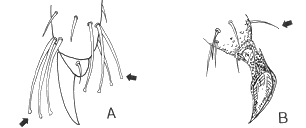 |
|
2(1). Sense organ of third antennal segment in adults with 2-3 greatly thickened dorsal sensory clubs (fig.2c&d)......... 3 Sense organ of third antennal segment in adults with one greatly thickened dorsal sensory club (fig.2a&b)......... 30 |
|
 |
|
3(2). Abdomen vi with midventral projection - best seen in ventral view (fig.3).............................................. 4 Abdomen vi without midventral projection.................... 7 |
|
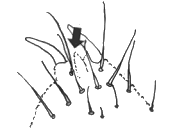 |
|
4(3). Sense organ of third antennal segment with 2 dorsal sense clubs (fig.4)............................................. 5 Sense organ of third antennal segment with 3 dorsal sense clubs (fig.2d).................................. Dinaphorura |
|
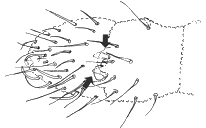 |
|
5(4). Dorsum of sixth abdominal segment with supplementary "spines" in front of typical anal spines (fig.5)................... 6 Dorsum of sixth abdominal segment without supplementary spines.......................................... Metaphorura |
|
 |
|
6(5). Anterior spines on sixth abdominal segment are mere granular projections (fig.5a)........................ Delamarephorura Anterior spines on sixth abdominal segment similar to more posterior "spines" (fig.5b).................... Marcuzziella |
|
7(3). Number of anal spines four or more.......................... 8 Number of anal spines two.................................. 11 |
|
8(7). Number of anal spines at most four.......................... 9 Number of anal spines more than four (fig.6)..... Neonaphorura |
|
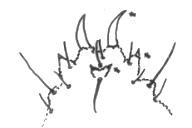 |
|
9(8). Pseudocelli crescentic (fig.7a).................... Anaphorura Pseudocelli varied but not crescentic (fig.7b&c)........... 10 |
|
 |
|
10(9). Postantennal organ rows of "tubercles" arranged in 4-7 units (fig.8a)..................................... Fissuraphorura Postantennal organ vesicles 40 or more, not arranged in distinct units (fig.8b)........................ Stenaphorura |
|
 |
|
11(7). Anal spines branched (fig.9).................... Neotullbergia Anal spines simple......................................... 12 |
|
 |
|
12(11). Postantennal organ oval to elongate linear. (fig.10a&b).... 13 Postantennal organ rounded. (fig.10c)...................... 29 |
|
 |
|
13(12). Postantennal organ with 17 or more vesicles, in rows....... 14 Postantennal organ with 5-8 vesicles only.................. 26 |
|
14(13). Postantennal organ tubercles in 2 clear rows for most of the organs' length (fig.10b)................................. 15 Postantennal organ tubercles in at least 3 rows (fig.10a).. 24 |
|
15(14). Sense organ of third antennal segment with 2 dorsal sense clubs (fig.11a).......................................... 16 Sense organ of third antennal segment with 3 dorsal sense clubs (fig.11b).......................................... 22 |
|
 |
|
16(15). Sixth abdominal segment with crescentic ridges behind pseudocelli and modified seta of fifth abdominal segment (fig.12)................................................. 17 Sixth abdominal segment without crescentic ridges.......... 18 |
|
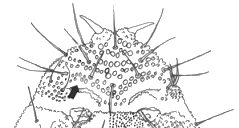 |
|
17(16). Sixth abdominal segment dorsally smooth except for crescentic ridges.......................................... Mesaphorura Sixth abdominal segment with additional dorsal or lateral tubercles bearing strong bristles (fig.13)... Paratullbergia |
|
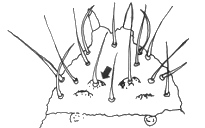 |
|
18(16). Pseudocelli of fifth abdominal segment in normal, lateral position................................................. 19 Pseudocelli of fifth abdominal segments on adjacent dorsal tubercles (fig.14)............................... Boudinotia |
|
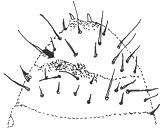 |
|
19(18). Dorsal trunk macrochaetae conspicuously longer than mesochaetae (fig.15)................................ Weinera Dorsal trunk setae all similar in size..................... 20 |
|
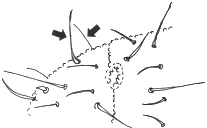 |
|
20(19). Pseudocelli of fifth abdominal segment crescentic, like remaining trunk pseudocelli (fig.16a).................... 21 Pseudocelli of fifth abdominal segment stellate, unlike remaining trunk pseudocelli (fig.16b)......... Psammophorura |
|
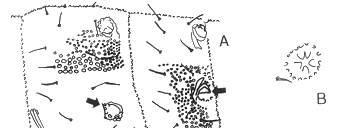 |
|
21(20). Number of tubercles in each row of the postantennal organ 16 or fewer (fig.17a)............................... Pongeiella Number of tubercles in each row of the postantennal organ more than 200 (fig.17b)............................ Chaetophorura |
|
 |
|
22(15). Postantennal organ rows of "tubercles" arranged in 4-7 units (fig.18)..................................... Fissuraphorura 1 Postantennal organ vesicles 40 or more, not arranged in distinct tubercles....................................... 23 |
|
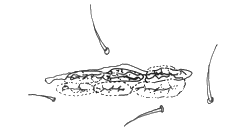 |
|
23(22). Anal spine length 0. 3-0. 4 times as long as third claw....... ................................................. Tillieria Anal spine length 0. 8-1. 4 times as long as third claw....... ................................................ Tullbergia |
|
24(14). Crescentic ridges absent on dorsum of sixth abdominal segment. ............................................. Chaetophorura 3 Crescentic ridges on dorsum of sixth abdominal segment (fig.12)................................................. 25 |
|
25(24). Postantennal organ vesicles arranged in 5 or more rows for at least part of postantennal organ length (fig.19a)........... ............................................. Multivesicula Postantennal organ vesicles in 4 rows (fig.19b)............... ............................................ Granuliphorura |
|
 |
|
26(13). Postantennal organ tubercles in 2 distinct rows............ 27 Postantennal organ tubercles in depression, not in distinct rows (fig.20a&b)......................................... 28 |
|
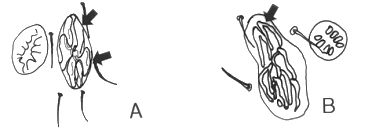 |
|
27(26). Sense organ of third antennal segment with 2 dorsal sense clubs............................................ Prabhergia Sense organ of third antennal segment with 3 dorsal sense clubs........................................ Fissuraphorura 2 |
|
28(26). Postantennal organ tubercles linear or anvil-shaped (fig.20a). ............................................... Karlstejnia Postantennal organ tubercles v- or y-shape, deeply divided (fig.20b)....................................... Wankeliella |
|
29(12). Tergites none with more than 1 + 1 pseudocelli.. Tullbergiella Tergites some with more than 1 + 1 pseudocelli. Rotundiphorura |
|
30(2). Claws normal............................................... 31 Claws with a handle-like basal and a shovel-like distal part (fig.21)...................................... Scaphaphorura |
|
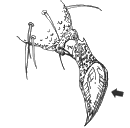 |
|
31(30). Sense organ of third antennal segment with 1 swollen and 2 slender sense clubs (fig.2a)..................... Tasphorura Sense organ of third antennal segment with 1 swollen sense club only (fig.2b)....................................... 32 |
|
32(31). Postantennal organ vesicles 6 (fig.22a)............... Jevania Postantennal organ vesicles at least 10 (fig.22b).......... 33 |
|
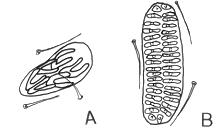 |
|
33(32). Postantennal organ vesicle often with clear central stem and vesicles not depressed in integument (fig.22b).... Doutnacia Postantennal organ vesicle without central stem and vesicles depressed in integument (fig.23).............. Najtiaphorura |
|
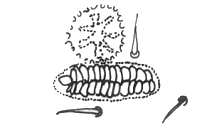 |
|
Endnotes
1 The PAO tubercles of Fissuraphorura are papillate, and at certain levels of focus the tubercles may be obscured by the papillae, giving the impression of a large number of irregularly arranged tubercles.
2 Fissuraphorura is keyed out at several points because the postantennal organ looks different depending on the level of focus.
3 In Chaetophorura the number of sense clubs in the sense organ of the third antennal segment is variable.